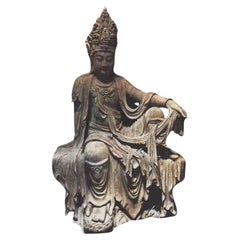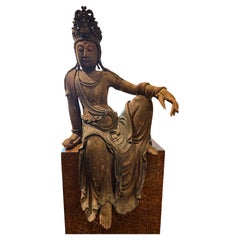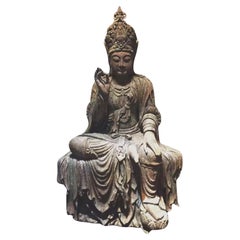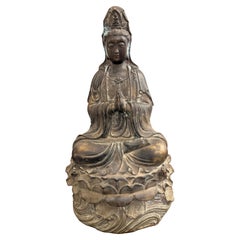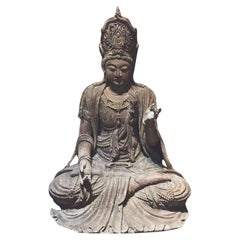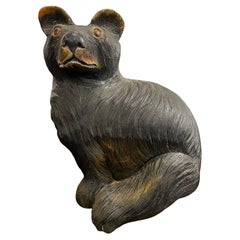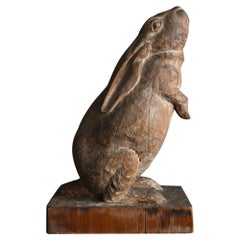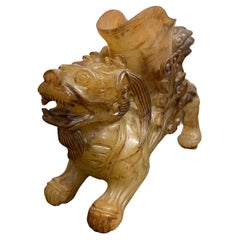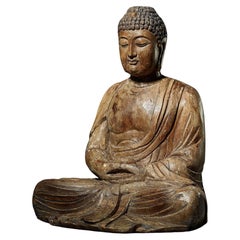Victoria - Sculptures and Carvings
to
8
2,056
1,463
20
10
7
3
2
16
4
4
3
2
20
19
11
8
20
20
20
Item Ships From: Victoria
A Large Chinese Carved Wood Figure of Guanyin, Late Qing Dynasty
Located in ARMADALE, VIC
Description:
A fine depiction of Guanyin, possessing the regal tranquillity that the Chinese Bodhisattva of compassion has come to be visually associated with. Marked by an urna signifying her spiritual enlightenment and crowned with a diadem depicting the Buddha Amitabha, the figure is immediately recognisable as Guanyin. Her androgynous figure is gracefully poised in the Lalit asana or “royal ease”, the pose classical in representations of the deity. The figure is asymmetric, with the weight of her supple form falling upon her left hand placed against the base, her right knee raised and left pendant. Her right hand rests upon her raised knee, delicately pinching at her draped attire. At first unassuming, this gesture may be suggestive of the Apana Mudra, the seal of purification. This Mudra is associated with physical wellbeing, fecundity and the cleansing of the body. Though she is adorned in the princely garb of dhoti, she bears features of idealised feminine beauty as prescribed in Asian art. With plump cheeks and near pouted lips, her full face gazes down upon the viewer with an empathetic and half-lidded gaze, upholding her title as ‘One who hears the cries of the world.’
Notes on the item:
Guanyin is the Chinese interpretation of Avalokiteshvara, the Indian Bodhisattva of compassion. The term “Bodhisattva” is derived from the Sanskrit “Bodhi”, meaning ‘awakening’ or ‘enlightenment’, combined with “Sattva”, meaning ‘spirit’ or ‘being’, referring to one on the path to achieving enlightenment. Bodhisattvas in Mayahana Buddhism are recognised as figures who have effectively achieved enlightenment yet relinquish their accension to nirvana in order to remain amongst mankind in the ultimate act of compassion to aid as spiritual guides. As such, the Bodhisattva inhabit a liminal space between samsara and nirvana; enlightened beings that maintain a relationship with humanity that buddhas cannot, as attaining Buddhahood necessitates the abandonment of all worldly attachments, including mankind. Guanyin’s very name, ‘One who hears the cries of the world’ highlights this role as a compassionate figure who acknowledges the suffering and strife of man. Along with Mahāsthāmaprāpta, a fellow bodhisattva, Guanyin serves as an attendant to Buddha Amitabha, with these three deities recognised as the Three Sages of Western Pure Land Buddhism, a sect of Mayahana Buddhism popular in East Asia.
Avalokiteshvara is commonly posited to have been adopted from Indian Buddhism into China as Guanyin around 200-400 CE, however it was the Tang dynasty (618-907) which saw the popularisation of the deity. By the Ming (1358–1644) and Qing (1644–1911) dynasties, Guanyin held the position as the most popular female deity in China. The unique state of religion in China held no monolithic canon regarding Buddhism and saw the assimilation of several belief systems, primarily Daoism, Buddhism and Confucianism. Consequently, Guanyin became a deity to be revered beyond Buddhism alone, appointed as both an official imperial deity and Daoist deity in the 12th century. Guanyin may also be seen to fulfil the role of idealised femininity as prescribed by Confucianism, with the scarcity of female Chinese deities perhaps accounting for the gradual gender shift Guanyin underwent.
The Indian Avalokiteshvara is unequivocally recognised as male, whilst the supposed gender of Guanyin remains contentious. Although there is a clear shift from the masculine Avalokiteshvara towards a more feminine representation, it is unclear if Guanyin is understood to be entirely feminine, to inhabit qualities of both genders or to be elevated beyond gender entirely, embodying neither. Depictions of Guanyin are highly androgynous, which some believe lends credence towards Guanyin symbolising the unity of dualistic forces as recognised in Daoism, displaying the anthropomorphism of yin and yang.
Comparative Analysis:
Market comparisons of similar Qing Dynasty polychrome figures of Guanyin include lot 767 (no.2) From Christies ‘Important Chinese Ceramics and Works of Art,’ New York, 25 March 2022, with the price realised USD 52,920 (Estimate USD 20,000 – USD 30,000). Christies also auctioned a comparable polychrome Guanyin...
Category
Late 19th Century Chinese Qing Antique Victoria - Sculptures and Carvings
Materials
Hardwood
An Important Chinese Carved Wood Figure of Guanyin, Ming Dynasty, 17th Century
Located in ARMADALE, VIC
An Important Chinese Carved Wood Figure of Guanyin, Ming Dynasty, 17th Century
Description:
A dignified portrayal of the bodhisattva, respl...
Category
17th Century Chinese Ming Antique Victoria - Sculptures and Carvings
Materials
Wood
A Large Chinese Carved Wood Figure of Guanyin, Late Qing Dynasty
Located in ARMADALE, VIC
An impressive depiction of Guanyin, the Bodhisattva of compassion, whose name bears the meaning ‘One who hears the cries of the world.’ The rather androgynous figure is adorned with beaded jewellery and the princely regalia of a dhoti, draped across her body and spilling out over to partially obscure what she is resting upon. The goddess’ profile exhibits idealised features of Asian artistic convention; her face is soft and rounded, with full lips and relaxed eyes that provide a serene quality of youthfulness to the figure. Adhering to Chinese iconography of Guanyin, the figure is marked by an urna on her forehead, denoting her own enlightenment, as well as a diadem displaying Buddha Amitabha, the spiritual teacher of Guanyin. Seated in the Lalit asana pose, translated as ‘royal ease’, the figure exudes a fine example of the relaxed majesty typical in the characterisation of Guanyin. Whilst the figure’s left hand is placed restfully upon the left leg pendant, the right is raised in the gesture shuni mudra, the second finger held gently against the thumb. Otherwise known as the seal of patience, this gesture indicates the figure as one intended to bestow this virtue, along with compassion and understanding, upon the beholder.
Notes on the item:
Guanyin is the Chinese interpretation of Avalokiteshvara, the Indian Bodhisattva of compassion. The term “Bodhisattva” is derived from the Sanskrit “Bodhi”, meaning ‘awakening’ or ‘enlightenment’, combined with “Sattva”, meaning ‘spirit’ or ‘being’, referring to one on the path to achieving enlightenment. Bodhisattvas in Mayahana Buddhism are recognised as figures who have effectively achieved enlightenment yet relinquish their accension to nirvana in order to remain amongst mankind in the ultimate act of compassion to aid as spiritual guides. As such, the Bodhisattva inhabit a liminal space between samsara and nirvana; enlightened beings that maintain a relationship with humanity that buddhas cannot, as attaining Buddhahood necessitates the abandonment of all worldly attachments, including mankind. Guanyin’s very name, ‘One who hears the cries of the world’ highlights this role as a compassionate figure who acknowledges the suffering and strife of man. Along with Mahāsthāmaprāpta, a fellow bodhisattva, Guanyin serves as an attendant to Buddha Amitabha, with these three deities recognised as the Three Sages of Western Pure Land Buddhism, a sect of Mayahana Buddhism popular in East Asia.
Avalokiteshvara is commonly posited to have been adopted from Indian Buddhism into China as Guanyin around 200-400 CE, however it was the Tang dynasty (618-907) which saw the popularisation of the deity. By the Ming (1358–1644) and Qing (1644–1911) dynasties, Guanyin held the position as the most popular female deity in China. The unique state of religion in China held no monolithic canon regarding Buddhism and saw the assimilation of several belief systems, primarily Daoism, Buddhism and Confucianism. Consequently, Guanyin became a deity to be revered beyond Buddhism alone, appointed as both an official imperial deity and Daoist deity in the 12th century. Guanyin may also be seen to fulfil the role of idealised femininity as prescribed by Confucianism, with the scarcity of female Chinese deities perhaps accounting for the gradual gender shift Guanyin underwent.
The Indian Avalokiteshvara is unequivocally recognised as male, whilst the supposed gender of Guanyin remains contentious. Although there is a clear shift from the masculine Avalokiteshvara towards a more feminine representation, it is unclear if Guanyin is understood to be entirely feminine, to inhabit qualities of both genders or to be elevated beyond gender entirely, embodying neither. Depictions of Guanyin are highly androgynous, which some believe lends credence towards Guanyin symbolising the unity of dualistic forces as recognised in Daoism, displaying the anthropomorphism of yin and yang.
Comparative Analysis:
Market comparisons of similar Qing Dynasty polychrome figures of Guanyin include lot 767 (no.2) From Christies ‘Important Chinese Ceramics and Works of Art,’ New York, 25 March 2022, with the price realised USD 52,920 (Estimate USD 20,000 – USD 30,000). Christies also auctioned a comparable polychrome Guanyin...
Category
Late 19th Century Chinese Qing Antique Victoria - Sculptures and Carvings
Materials
Hardwood
A Chinese Bronze Seated Guanyin, 19th Century
Located in ARMADALE, VIC
A Chinese Bronze Seated Guanyin, 19th Century
Guanyin is the Buddhist bodhisattva associated with compassion. In the East Asian world, Guanyin is the equivalent term for Avalokitesv...
Category
19th Century Chinese Qing Antique Victoria - Sculptures and Carvings
Materials
Bronze
A Large Chinese Carved Wood Figure of Guanyin, Late Qing Dynasty
Located in ARMADALE, VIC
Description:
A singular example of Guanyin. Deviating from the Bodhisattva’s conventional pose of ‘royal ease’, the figure is instead seated in the meditative padmasana, or ‘lotus position’, rendering this Guanyin something of a rarity. An Apana more typically associated with depictions of Buddhas, Guanyin assuming this pose immediately signifies this figure as one of particular spiritual reverence. Both feet are revealed crossed upon one another from beneath fabric which spills before her, her left palm turned upward with her hand resting upon her left knee and her right raised in a relaxed gesture. Adorned with a diadem housing a depiction of Amitabha Buddha, her own spiritual guide, she exudes an air of tranquil regality, further characterised by her numerous strings of beads and elaborately fastened dhoti, attire traditionally reserved for Indian princes. Though the figure’s dress is Indian her face is undoubtedly exemplifying artistic Chinese beauty standards. Her face is soft and rounded, full in both the lips and cheeks, with eyes that restfully peer down, as though she is watching over the worries of mankind with compassion.
Notes on the item:
Guanyin is the Chinese interpretation of Avalokiteshvara, the Indian Bodhisattva of compassion. The term “Bodhisattva” is derived from the Sanskrit “Bodhi”, meaning ‘awakening’ or ‘enlightenment’, combined with “Sattva”, meaning ‘spirit’ or ‘being’, referring to one on the path to achieving enlightenment. Bodhisattvas in Mayahana Buddhism are recognised as figures who have effectively achieved enlightenment yet relinquish their accension to nirvana in order to remain amongst mankind in the ultimate act of compassion to aid as spiritual guides. As such, the Bodhisattva inhabit a liminal space between samsara and nirvana; enlightened beings that maintain a relationship with humanity that buddhas cannot, as attaining Buddhahood necessitates the abandonment of all worldly attachments, including mankind. Guanyin’s very name, ‘One who hears the cries of the world’ highlights this role as a compassionate figure who acknowledges the suffering and strife of man. Along with Mahāsthāmaprāpta, a fellow bodhisattva, Guanyin serves as an attendant to Buddha Amitabha, with these three deities recognised as the Three Sages of Western Pure Land Buddhism, a sect of Mayahana Buddhism popular in East Asia.
Avalokiteshvara is commonly posited to have been adopted from Indian Buddhism into China as Guanyin around 200-400 CE, however it was the Tang dynasty (618-907) which saw the popularisation of the deity. By the Ming (1358–1644) and Qing (1644–1911) dynasties, Guanyin held the position as the most popular female deity in China. The unique state of religion in China held no monolithic canon regarding Buddhism and saw the assimilation of several belief systems, primarily Daoism, Buddhism and Confucianism. Consequently, Guanyin became a deity to be revered beyond Buddhism alone, appointed as both an official imperial deity and Daoist deity in the 12th century. Guanyin may also be seen to fulfil the role of idealised femininity as prescribed by Confucianism, with the scarcity of female Chinese deities perhaps accounting for the gradual gender shift Guanyin underwent.
The Indian Avalokiteshvara is unequivocally recognised as male, whilst the supposed gender of Guanyin remains contentious. Although there is a clear shift from the masculine Avalokiteshvara towards a more feminine representation, it is unclear if Guanyin is understood to be entirely feminine, to inhabit qualities of both genders or to be elevated beyond gender entirely, embodying neither. Depictions of Guanyin are highly androgynous, which some believe lends credence towards Guanyin symbolising the unity of dualistic forces as recognised in Daoism, displaying the anthropomorphism of yin and yang.
Comparative Analysis:
Market comparisons of similar Qing Dynasty polychrome figures of Guanyin include lot 767 (no.2) From Christies ‘Important Chinese Ceramics and Works of Art,’ New York, 25 March 2022, with the price realised USD 52,920 (Estimate USD 20,000 – USD 30,000). Christies also auctioned a comparable polychrome Guanyin...
Category
Late 19th Century Chinese Qing Antique Victoria - Sculptures and Carvings
Materials
Hardwood
A Japanese Wooden Carved Bear, 20th Century
Located in ARMADALE, VIC
A Japanese Wooden Carved Bear, 20th Century
Home decor, interior design and collectibles.
Provenance: Private Australian Collection.
Dimensions:
Height: 37cm
Width: 32cm
Depth: 27cm
Category
20th Century Japanese Victoria - Sculptures and Carvings
Materials
Wood
Japanese Theatre Mitsumekozo Theatre Mask Meiji Period, circa 1900
Located in Prahran, Victoria
Unusual Japanese Folk Art theatre mask depicting the playful character Mitsumekozo, a three eyed goblin often portrayed as a mischevious creature in comical plays, late Meiji period,...
Category
Late 19th Century Japanese Meiji Antique Victoria - Sculptures and Carvings
Materials
Wood
$760 Sale Price
20% Off
Antique Japanese Statue of Dakini Ten
Located in Prahran, Victoria
Rare and highly unusual antique Japanese statue of the esoteric deity 'Dakini Ten,' a Buddhist goddess who was associated with the agricultural...
Category
1770s Japanese Antique Victoria - Sculptures and Carvings
Materials
Gesso, Wood
A Small Chinese Carved Timber Polychrome Figure, Ming Dynasty
Located in ARMADALE, VIC
A Small Chinese Carved Timber Polychrome Figure, Ming Dynasty
Provenance:
Private Australian Collection Acquired in the Beijing Market in 1980s.
Description:
The cavity in the ba...
Category
17th Century Chinese Ming Antique Victoria - Sculptures and Carvings
Materials
Wood
$595 Sale Price
50% Off
A Chinese Bronze Seated Guanyin with Mark, 19th Century
Located in ARMADALE, VIC
A Chinese Bronze Seated Guanyin with Mark, 19th Century
Guanyin is the Buddhist bodhisattva associated with compassion. In the East Asian world, Guanyin is the equivalent term for A...
Category
19th Century Chinese Qing Antique Victoria - Sculptures and Carvings
Materials
Bronze
A Small Chinese Carved Timber Gilt and Polychrome Figure, Ming Dynasty
Located in ARMADALE, VIC
A Small Chinese Carved Timber Gilt and Polychrome Figure, Ming Dynasty
Provenance: Private Old Australian Collection Acquired in Beijing Market in 1980s.
Description:
A devotional...
Category
17th Century Chinese Ming Antique Victoria - Sculptures and Carvings
Materials
Wood
$605 Sale Price
50% Off
An Antique Bronze Figure of a Standing Buddha, 19th Century
Located in ARMADALE, VIC
An Antique Bronze Figure of a Standing Buddha, 19th Century
Provenance:
Private Australian Collection.
Description:
The figure standing upright and exhibiting a serene facial exp...
Category
19th Century Asian Antique Victoria - Sculptures and Carvings
Materials
Bronze
A Small Chinese Carved Timber Gilt and Polychrome Figure, Ming Dynasty
Located in ARMADALE, VIC
A Small Chinese Carved Timber Gilt and Polychrome Figure, Ming Dynasty
Provenance:
Private Old Australian Collection Acquired in Beijing Market in 1980s.
Description:
The cavity ...
Category
17th Century Chinese Ming Antique Victoria - Sculptures and Carvings
Materials
Wood
$675 Sale Price
50% Off
A Solid Cast Bronze Japanese Figure of Bear, Early 20th Century
Located in ARMADALE, VIC
A Solid Cast Bronze Japanese Figure of Bear, Early 20th Century
Dimension: Height: 15cm Width: 26cm Depth: 11.5cm
Provenance: Private Melbourne Collection.
Category
Early 20th Century Japanese Victoria - Sculptures and Carvings
Materials
Bronze
$475 Sale Price
50% Off
A Small Chinese Carved Timber Gilt and Polychrome Figure, Ming Dynasty
Located in ARMADALE, VIC
A Small Chinese Carved Timber Gilt and Polychrome Figure, Ming Dynasty
Provenance: Private Old Australian Collection Acquired in Beijing Market in 1980s.
Description:
The cavity in...
Category
17th Century Chinese Ming Antique Victoria - Sculptures and Carvings
Materials
Wood
$560 Sale Price
60% Off
A Small Chinese Carved Timber Polychrome Figure, Ming Dynasty
Located in ARMADALE, VIC
A Small Chinese Carved Timber Polychrome Figure, Ming Dynasty
Provenance: Private Old Australian Collection Acquired in Beijing Market in 1980s.
Description:
The cavity in the back...
Category
17th Century Chinese Ming Antique Victoria - Sculptures and Carvings
Materials
Wood
$575 Sale Price
50% Off
Rare Antique Statue of a Chinese Child Performing Tai Chi
Located in Prahran, Victoria
Rare Japanese antique statue of a Chinese child performing Tai chi capturing the pose in motion. Middle Edo period, circa 1750. Made from polychrome on carved ...
Category
Mid-18th Century Japanese Edo Antique Victoria - Sculptures and Carvings
Materials
Cypress
$2,880 Sale Price
20% Off
Superb Example Antique Japanese Gilded Statue of a Shinto God, Momoyama Period
Located in Prahran, Victoria
A Japanese statue of a Shinto god from the Momoyama period. Hand carved from wood with a layer of gesso and hand painted flowing robes with delicately wroug...
Category
16th Century Japanese Antique Victoria - Sculptures and Carvings
Materials
Gesso, Wood
Rare Buddhist Carved Base for a Statue, Edo Period, 17th Century
Located in Prahran, Victoria
Rare and unusual hexagonal Buddhist base for a statue with a recumbent shi-shi (guardian lion dog), gilded and carved with inset glass eyes and painted with mineral pigments.
Most likely the base to a sculpture of Monju Bosatsu...
Category
Mid-17th Century Japanese Edo Antique Victoria - Sculptures and Carvings
Materials
Wood
Japanese Erotic Otofuku Folk Art Carving, Late Meiji Period, circa 1900
Located in Prahran, Victoria
Rare and highly unusual Japanese Folk Art wood carving depicting the folk heroine and good luck figure Otafuku with a finely painted erotic design on the interior and a carved inscri...
Category
Early 20th Century Japanese Meiji Victoria - Sculptures and Carvings
Materials
Cypress
Related Items
18th Century Hand-Carved Jichi Wood Guanyin Figure
Located in New York, NY
This beautiful sculpture realized in China in the 18th century depicts Guanyin, a Bodhisattva associated with compassion. The female form holds a pot in her hands. She appears draped...
Category
18th Century Chinese Qing Antique Victoria - Sculptures and Carvings
Materials
Hardwood
Old Japanese wooden rabbit figurine/20th century/carved animal
Located in Sammu-shi, Chiba
This is a wooden rabbit made in the Taisho to Showa eras (20th century) in Japan.
The sculptor's name is engraved on the bottom, and it seems to have been carved by a person named "O...
Category
20th Century Japanese Taisho Victoria - Sculptures and Carvings
Materials
Wood
Chinese Green Glazed Foo Lions, Near Pair, Late 19th Century, China
Located in Austin, TX
A charming near pair of Chinese green glazed foo lion joss stick holders, late 19th century, China.
The delightful foo lions, also referred to as foo dogs, crafted as joss (incens...
Category
Late 19th Century Chinese Qing Antique Victoria - Sculptures and Carvings
Materials
Stoneware
$1,750 / set
H 10 in W 4 in D 5 in
Old Japanese wooden frog figurine / 20th century / wood carving figurine
Located in Sammu-shi, Chiba
I have acquired something very unique.
I would like to introduce an old Japanese wooden carved frog ornament.
The frog is standing and in a pose similar ...
Category
20th Century Victoria - Sculptures and Carvings
Materials
Wood
$1,500
H 17.56 in W 15.36 in D 6.93 in
Large Late Qing Dynasty Chinese Cast Bronze Buddhistic Foo Lion Censer
Located in Austin, TX
A large and powerfully cast Chinese bronze censer in the form of two Buddhistic lions, Qing dynasty, late 19th century. The censer is well cast with a strong sense of movement, featuring a pair of fierce Buddhistic lions playfully antagonizing each other. Locked in a mock battle, the smaller lion...
Category
Late 19th Century Chinese Qing Antique Victoria - Sculptures and Carvings
Materials
Bronze
$4,800
H 10.25 in W 8 in D 12 in
Chinese Small Cizhou Glazed Figure of a Daoist Deity, Song to Ming Dynasty
Located in Austin, TX
A small and charming Chinese cizhou ware glazed pottery figure of a Taoist deity or official, Song to Ming Dynasty, 13th - 15th century, China, ex. Christi...
Category
15th Century and Earlier Chinese Ming Antique Victoria - Sculptures and Carvings
Materials
Stoneware
$1,500
H 5.5 in W 3.13 in D 2.25 in
Large Chinese Carved Nephrite Jade Double Buddha's Hand Vase, Late Qing Dynasty
Located in Austin, TX
A large and graceful carved nephrite jade conjoined double vase in the form of a pair of Buddha's hands fruit (finger citron), late Qing Dynasty, circa 1900, China.
The large and heavy vase carved from a single piece of celadon nephrite jade, with areas of lighter brown "sugar" skin. The vase ingeniously carved as a pair of Buddha's hand fruit, also known as finger citron, rising from a gnarled, leafy branch. The smaller Buddha's hand with a pair of bats. The Buddha's hands fruit with elegant and naturalistic curved "fingers". The "fingers wonderfully shaped and reticulated. The body of the fruit with simple stippling, in imitation of the textured surface of the real fruit. The interior of each fruit well hollowed and able to hold water.
Buddha's hands fruit are auspicious in Chinese culture. Their name in Chinese "Fo Shou" is a homophone for "Happiness and Longevity. They are often placed as offerings on Buddhist altars...
Category
Early 1900s Chinese Qing Antique Victoria - Sculptures and Carvings
Materials
Jade
$9,800
H 8.75 in W 6.25 in D 3.5 in
Chinese Carved Boxwood Figure of Guanyin, Mid-Qing Dynasty
Located in Austin, TX
A sublime Chinese carved boxwood figure of the Bodhisattva of Compassion, Avalokiteshvara, called Guanyin in Chinese, mid-Qing dynasty.
The an...
Category
Late 18th Century Chinese Qing Antique Victoria - Sculptures and Carvings
Materials
Boxwood
Chinese White Jade Open Late Qing Dynasty Plaque
By Alba China
Located in Sarasota, FL
Chinese white jade openwork plaque late Qing Dynasty depicting birds and flowers. Very fine and detailed work. Small loss on the back side of the pl...
Category
19th Century Chinese Chinese Export Antique Victoria - Sculptures and Carvings
Materials
Jade
Ming Dynasty Bronze Figure of the Infant Buddha
Located in Austin, TX
A rare and unusual Chinese Ming Dynasty bronze figure of the Buddha as an infant. The young Prince Siddhartha, who would grow up to become the Buddha, is portrayed standing, one hand pointing to the sky, the other to the ground. He is naked, save for a baby apron...
Category
16th Century Chinese Ming Antique Victoria - Sculptures and Carvings
Materials
Bronze
Early 20th Century Chinese Qing Dynasty Large Jadeite Carved Plaque on Stand
Located in Hudson, NY
This very nice carved plaque of good size comes from China and was made circa 1900. The stone is a rich combination of dark, light and emerald green. Sliced from a boulder washed and...
Category
Early 20th Century Chinese Qing Victoria - Sculptures and Carvings
Materials
Jade
$2,950
H 8 in W 4.5 in D 3.5 in
Large Chinese Carved and Lacquered Buddha, Qing Dynasty, 19th Century
Located in Austin, TX
A large and magnificent near life-sized Chinese carved and lacquered wood figure of a Buddha, Qing Dynasty, 19th century or earlier, southern China.
The figure likely represents one of the Five Tathagatas, also known as Dhyani Buddhas or Wisdom Buddhas. More specifically, either Amitabha or Amoghasiddhi. Amitabha is the Buddha of infinite light, and represents the wisdom of observation and recognition. Amoghasiddhi is the Buddha of accomplishment, and represents the wisdom of perfected practices. The size and scale of the Buddha indicates it was made for temple worship.
The large Buddha is portrayed seated in vajrasana, or full lotus position, with the soles of both feet facing up. His elegant hands, with impossibly long and slender fingers, perform shuni mudra, the gesture of bestowing patience. His right arm is bent at the elbow, the right hand raised to heart level. The left arm resting gently in his lap, the left hand at navel level.
The Buddha is dressed in voluminous robes that wrap around his shoulders and body, and tied at the waist. The heavy fabric draping and pooling elegantly all around his robust body. His broad chest and right arm exposed.
The Buddha's face is both solemn and beatific - his expression seeming to change depending on the angle of view. The most notable feature of his face is the large urna to the center of his forehead, set between a pair of painted, high arching brows over heavily lidded almond shaped eyes. A strong nose is set above a small mouth pursed in an ever so slight smile. Long pendulous earlobes touch his shoulders.
The Buddha's hair arranged in the typical fashion, with "spikes" representing tight curls. A prominent ushnisha rises from the crown of his head, covered by more hair, and topped with a rounded protuberance.
The Buddha is constructed from several blocks of wood, joined, carved and lacquered a deep red-brown with gold flecks...
Category
19th Century Chinese Qing Antique Victoria - Sculptures and Carvings
Materials
Wood
$24,500
H 32 in W 22.25 in D 16 in
Previously Available Items
A Chinese Jade Carving of Piqiu, Late 19th Century
Located in ARMADALE, VIC
A Chinese Jade Carving of Piqiu, Late 19th Century
Dimension: Height: 11.5cm Width: 14.5cm Depth: 5.5cm
Provenance: Private old Australian coll...
Category
Late 19th Century Chinese Qing Antique Victoria - Sculptures and Carvings
Materials
Jade
A Large Carved Wooden Figure Of Buddha, Ming Dynasty
Located in ARMADALE, VIC
A LARGE CARVED WOODEN FIGURE OF BUDDHA, MING DYNASTY (1368-1644)
China, 1368-1644. Seated in dhyanasana, the arms lowered in dhyanamudra, holding an alms bowl, wearing long robes fa...
Category
Late 17th Century Chinese Ming Antique Victoria - Sculptures and Carvings
Materials
Hardwood
A Chinese Spinach Jade Duck Carving, Qing Dynasty
Located in ARMADALE, VIC
A large Chinese spinach jade duck carving, Qing Dynasty,
holding a lotus flower in her mouth, the interior hollow with detachable 'duckling' cover, with lab...
Category
19th Century Chinese Qing Antique Victoria - Sculptures and Carvings
Materials
Jade
Sepik River Crocodile Orators Stool or Side Table Papua New Guinea 1960s
Located in Melbourne, AU
A mid 20th Century Sepik River Crocodile stool, hand carved from a single piece of solid timber.
We suspect this stool is from the period immediately...
Category
1960s Papua New Guinean Tribal Vintage Victoria - Sculptures and Carvings
Materials
Hardwood
Hand Turned Post Modern Kauri Comport or Stand, 1990s
Located in Melbourne, AU
This stand has been hand turned from fine-grained Kauri Pine. It has an attractive pale straw colour and exquisite grain.
This comport or stand can be used to offer fruit, sushi ...
Category
1990s Australian Organic Modern Victoria - Sculptures and Carvings
Materials
Wood
Antique Japanese Carved Bamboo Toad, 19th Century
Located in Prahran, Victoria
Antique Japanese bamboo toad, 19th century, Meiji period, hand carved with glass eyes.
Dimensions: H 10.5cm x W 19cm x D 15cm
Category
19th Century Japanese Meiji Antique Victoria - Sculptures and Carvings
Materials
Bamboo
Antique Japanese Ceramic Wall Hanging with Erotic Underside, Meiji Period
Located in Prahran, Victoria
Antique Japanese hand modeled and painted pottery wall hanging in shape of Daruma with Shunga erotic design underside
Dimensions: H 14cm x W 1...
Category
1910s Japanese Meiji Vintage Victoria - Sculptures and Carvings
Materials
Ceramic
H 5.52 in W 4.34 in D 1.97 in
Rare Antique Japanese Statue of Daikoku in Gilt Zushi, circa 18th Century
Located in Prahran, Victoria
Rare Japanese antique statue of Daikoku inside a black lacquer zushi with gilded interior, Edo period, 18th century.
In Japanese mythology, Daikoku is the god of wealth...
Category
18th Century Japanese Edo Antique Victoria - Sculptures and Carvings
Materials
Gold Leaf
H 17.33 in W 12.6 in D 12.21 in
Antique Japanese Pair of Bronze Cranes 'Tsuru', Meiji Period
Located in Prahran, Victoria
Pair of large antique Japanese bronze cranes with finely detailed plumage. One crane holds its head head high, while the other has just plucked ...
Category
Early 20th Century Japanese Meiji Victoria - Sculptures and Carvings
Materials
Bronze
Rare Japanese Seto Pottery Folk Art Shishi Guardian Dogs, Meiji Period
Located in Prahran, Victoria
Rare pair of Japanese Folk Art Seto pottery shishi Buddhist guardian dogs glazed in a dark greenish brown toned glaze, late Meiji period
Acknowledged f...
Category
Early 20th Century Japanese Meiji Victoria - Sculptures and Carvings
Materials
Pottery
Pair of Japanese Seto Pottery Guardian Lion Figures, Showa Period, circa 1934
Located in Prahran, Victoria
Pair of Japanese Seto pottery shishi Buddhist guardian lions, both well modeled with comic expressions and powerful upright bodies and each bearing an inc...
Category
1930s Japanese Showa Vintage Victoria - Sculptures and Carvings
Materials
Pottery
H 12.01 in W 8.67 in D 5.12 in
Exceptional Set of 18 Japanese Temple Flowers in Bronze Vases, Edo Period
Located in Prahran, Victoria
Rare and exceptional set of eighteen Japanese Buddhist temple flowers with their original heavily cast bronze vases.
Each of the flowers rea...
Category
Early 19th Century Japanese Edo Antique Victoria - Sculptures and Carvings
Materials
Bronze
H 59.06 in W 39.38 in D 25.6 in
Read More
12 Calming Spaces Inspired by Japanese Design
From cherry-blossom-adorned walls paired with glamorous lighting to wood-paneled ceilings above checkerboard-patterned chairs, these 12 spaces seamlessly blend Eastern and Western aesthetics.
Rodrigo Rivero Lake’s Mexico City Showroom Is a Museum-Worthy Trove of Spanish Colonial and Asian Antiques
The dealer and curator has spent the past 50 years amassing a collection of exceptional art, furniture and architectural elements that trace the cultural influence of the Spanish empire from Europe to the Americas and beyond.
Recently Viewed
View AllMore Ways To Browse
Japanese Daruma
Rice Pounder
Indonesian Stone Carving
Japan Bronze Buddha Statue
Japanese Kimono Doll
Japanese Root Carving
Nat Statue
Japanese Carved Dog
Japanese Ivory Carvings
Japanese Toad
Japanese Wood Okimono
Ningyo Dolls
Indian Stone Head
Jade Bi Disc
Japanese Rabbit Sculpture
Jizo Bosatsu
Meiji Bronze Samurai
Moon Gazing
